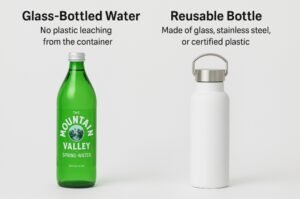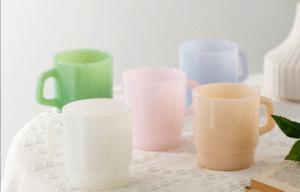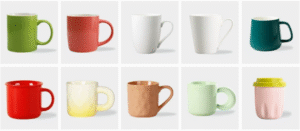You've seen those classic, opaque white mugs in vintage shops. You love their nostalgic charm, but you wonder if there's a real market for them today beyond collectors and antique hunters.
Milk glass is a type of opaque white glass that was highly popular in the mid-20th century. While it's no longer mass-produced, its durable nature and strong retro appeal present a unique opportunity for brands to launch new, vintage-inspired drinkware lines.
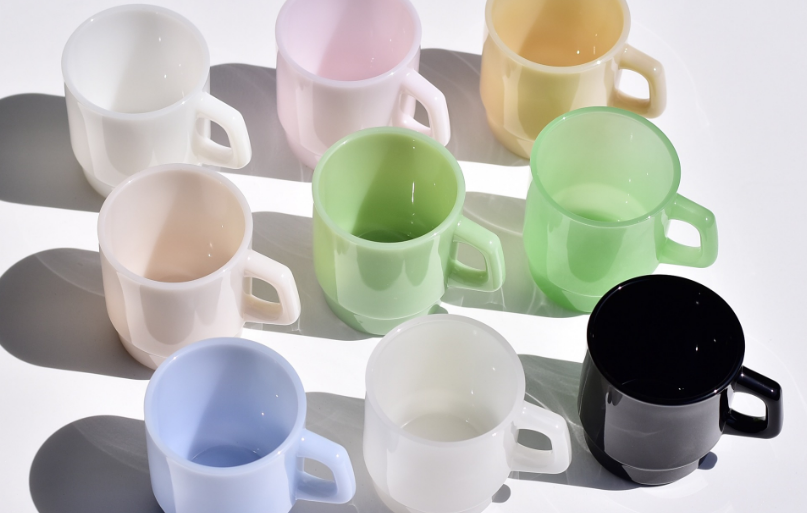
I often tell product developers to look to the past for future inspiration. The story of milk glass is a perfect example. It's not just about a material; it's about a feeling. It reminds people of their grandmother's kitchen or a classic American diner. In an industry saturated with stainless steel and minimalist ceramics, reviving a style like milk glass can make a brand stand out. It taps into the powerful emotions of nostalgia and comfort, which are things customers are always willing to buy.
Why is milk glass no longer made?
You see these brilliant white mugs everywhere in antique shops, but they are absent from modern retail shelves. What happened to make such a seemingly popular material disappear from production lines?
Milk glass stopped being mass-produced primarily because consumer tastes changed. In the 1970s and 80s, preferences shifted to earthy ceramic tones and clear glass. High production costs and the financial struggles of its main manufacturers also led to its decline.
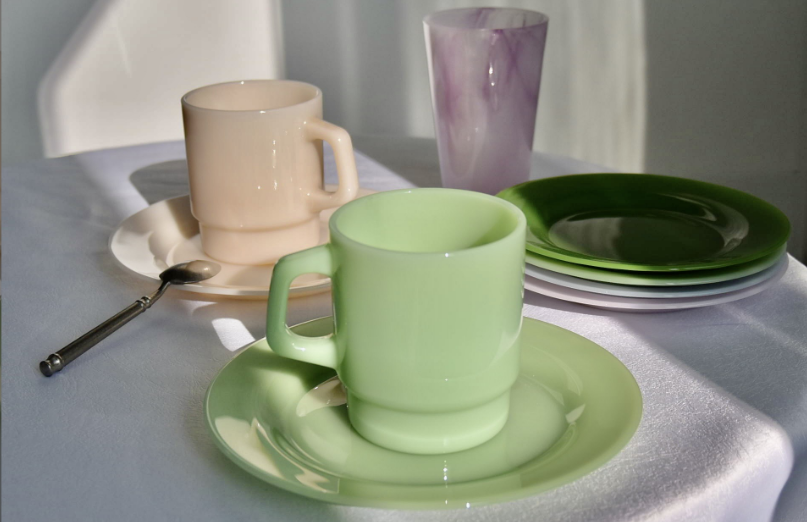
I've seen these market shifts happen over and over in my career. A product that is a bestseller one decade can be obsolete the next. Milk glass faced a perfect storm. The clean, wholesome, mid-century look it represented fell out of fashion. At the same time, improvements in automated ceramic production made stoneware mugs cheaper and available in the trendy colors people wanted. For a developer like Emily, this is a key lesson: even the best materials can't survive a major shift in cultural aesthetics.
The Factors Behind Its Disappearance
The decline of milk glass wasn't a single event but a gradual process driven by several key factors.
- Evolving Consumer Tastes: The biggest driver was fashion. The 1950s and 60s were the heyday of milk glass, fitting perfectly with the bright, optimistic decor of the time. But the 1970s brought a shift to earth tones—avocado green, harvest gold, and rustic oranges—where milk glass looked dated. The 80s and 90s moved towards other styles, leaving milk glass behind.
- Intense Competition: The market for housewares became incredibly competitive. Ceramic mugs could be produced very cheaply and in an endless variety of colors and patterns. At the same time, brands like Pyrex were perfecting their clear, heat-resistant glass, which consumers saw as more modern.
- Production Economics: Making high-quality milk glass was a specialized process. It required specific chemical opacifying agents and careful temperature controls. As demand fell, it became less economically viable for large factories to dedicate production lines to it compared to more profitable clear glass or other products. Many of the iconic producers, like Anchor Hocking, streamlined their catalogs to survive.
What is a milk glass mug?
Now that you know why it vanished, you may be asking what "milk glass" even is. Is it just white-colored glass, or is there something more specific to this unique material?
A milk glass mug is drinkware made from an opaque, milky-white glass. It gets its signature look by adding specific opacifying agents, like tin dioxide or bone ash, to the molten glass before it is pressed into its final shape.
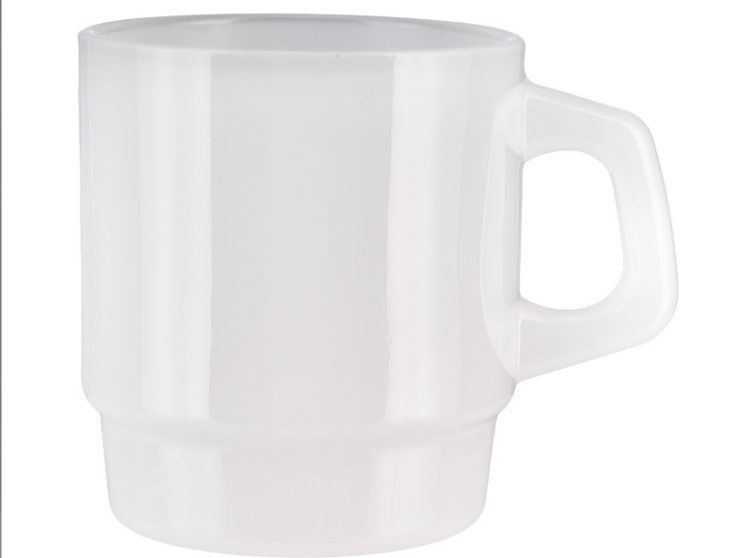
The first time I held a genuine, I was struck by its feeling. It has a unique density and smoothness that is different from both ceramic and regular glass. It feels substantial and durable. For a product developer, this tactile quality is just as important as the visual look. You are selling an experience. The goal of a modern milk glass-style mug should be to replicate that satisfying feeling of quality and permanence that made the originals so beloved.
Understanding the Material
Milk glass is not simply painted or coated; its color is inherent to its structure. A developer needs to understand its core properties to appreciate its potential.
| Property | Description | Advantage for Drinkware |
|---|---|---|
| Composition | Soda-lime glass mixed with an opacifier. This additive scatters light, making the glass opaque. | Creates a unique, soft, and uniform white color that does not fade, chip, or scratch off. |
| Manufacturing | Typically "pressed glass," where molten glass is pressed into a mold. | Allows for durable, thick-walled construction and consistent shapes, ideal for mugs. |
| Durability | Very strong and resistant to chipping and breaking compared to ceramic or standard glass of the time. | A key selling point in its day, contributing to its reputation as a long-lasting product. |
| Surface | Non-porous. It does not absorb flavors, odors, or stains. | Makes it very hygienic and easy to clean, ensuring a pure taste for coffee or tea. |
Its combination of elegance and toughness is what made milk glass a kitchen staple for decades. It had the delicate look of porcelain with the rugged utility of industrial glass.
Is milk glass worth anything today?
Knowing that it's a vintage material, you have to ask about its current value. Is this just a cheap flea market find, or does milk glass hold real value for collectors and designers?
Yes, milk glass is valuable, but its worth varies greatly. Rare, branded pieces in mint condition are highly sought after by collectors. For a product developer, its true value lies in the powerful nostalgic aesthetic that can be translated into new, commercially successful products.

I always tell my clients to distinguish between collector value and market value. Hunting for a rare $200 McKee milk glass platter is a collector's game. But recognizing that millions of people have fond memories of milk glass is a product developer's opportunity. The "worth" isn't in the old object itself, but in the emotion it represents. Harnessing that emotion to create a new, affordable, high-quality mug with that same beloved style is how you build a successful product line.
Two Kinds of Value
For someone like Emily, it's crucial to see value from two perspectives: the collector's market and the modern consumer market.
- For the Collector: The value of a vintage piece depends on specific factors.
- Brand: Pieces from well-known makers like Fire-King, Fenton, Westmoreland, and McKee are more desirable.
- Rarity: Unique shapes, limited-run patterns, and certain colors (like the famous green "Jade-ite" or the blue "Delphite") command high prices.
- Condition: Items without chips, cracks, or stains are exponentially more valuable.
- Markings: A clear maker's mark on the bottom can confirm authenticity and increase worth.
- For the Product Developer: The opportunity is not in reselling old items but in creating new ones.
- Nostalgia Marketing: The "grand-millennial" and "cottagecore" design trends are hugely popular. A milk glass-style mug fits perfectly into this aesthetic.
- Aesthetic Appeal: The clean, white, retro look is timeless and photographs beautifully for social media.
- Material Benefits: You can market a new version by emphasizing the classic benefits: durability, a non-porous surface for pure taste, and a comforting, substantial feel.
Why do they call it milk glass?
The name seems obvious, but what's the real story? Understanding the origin of the name can provide a powerful narrative that you can use for marketing and branding a new product line.
It is called milk glass because its classic, opaque whiteness directly resembles the appearance of a glass of milk. The name was a simple and effective marketing term that made the material feel familiar, wholesome, and pure to consumers.

The simplest names are often the most brilliant. The term "milk glass" is genius. Milk is associated with health, home, and childhood. By naming the material after it, manufacturers instantly gave their products this positive association. They weren't just selling a cup; they were selling a piece of the wholesome American kitchen ideal. When I help brands develop new products, I always remind them of this lesson: a good name tells a story and connects with the customer on an emotional level.
The History Behind the Name
The name is descriptive, but its history reveals its original purpose as a porcelain substitute.
- The Venetian Origins: The technique was first developed in Venice during the 16th century. The goal was to create a less expensive alternative to the highly prized, pure white porcelain being imported from China. Early versions were simply called "lattimo," from the Italian word for milk.
- The Victorian Era: The material saw a huge surge in popularity during the Victorian era. It was mass-produced in Europe and North America. The term "milk glass" became the common English name used by manufacturers and the public to describe this popular opaque white ware.
- Mid-Century Marketing: In the 20th century, companies like Anchor Hocking and Jeannette Glass leaned into the name. It perfectly suited the marketing of the post-war era, which emphasized cleanliness, modernity, and the ideal family home. The name helped position their durable mugs and dinnerware as perfect for everyday family life. The name wasn't just descriptive; it was aspirational.
Conclusion
Milk glass is a classic material defined by its history and nostalgic feel. Its decline in production has now created a market opportunity for new products that capture its timeless, comforting aesthetic.

